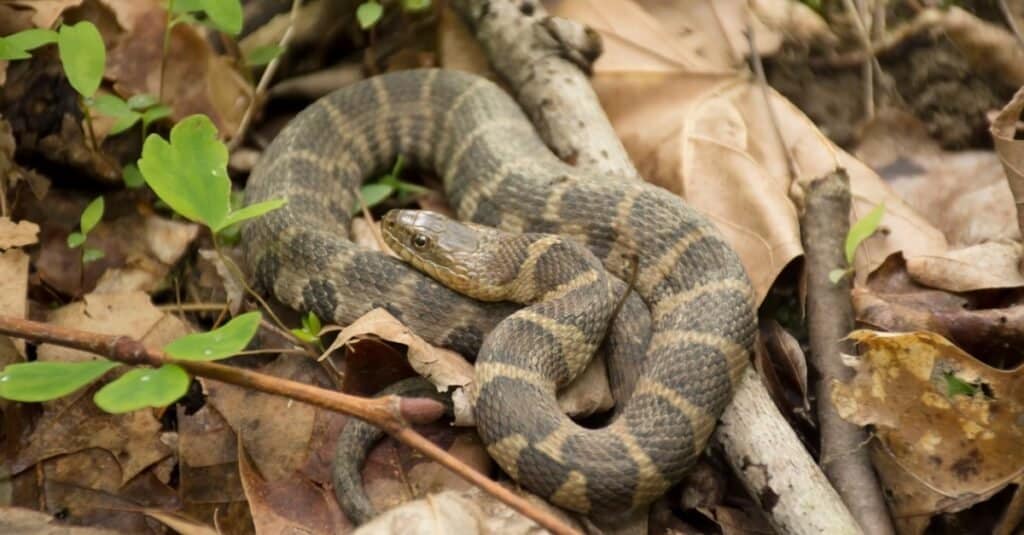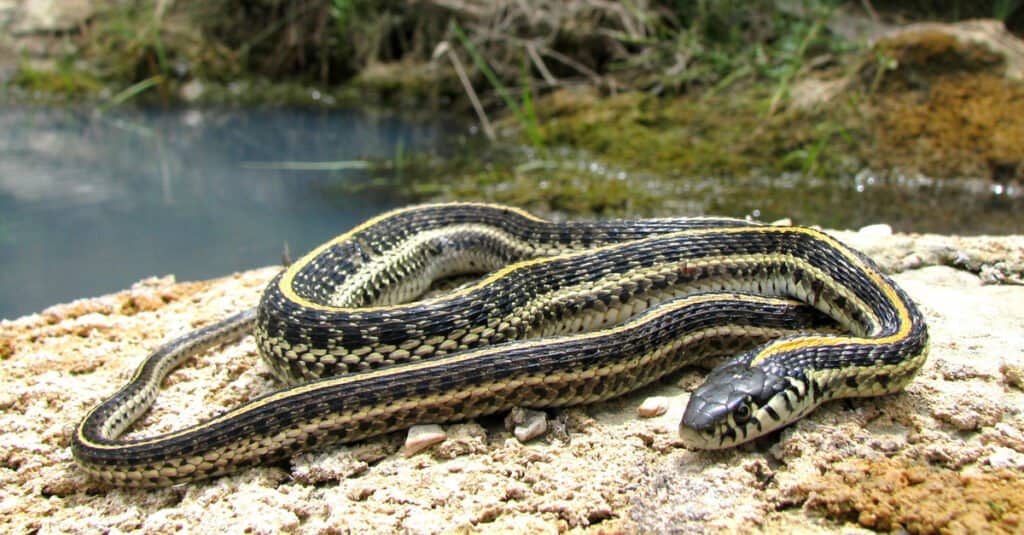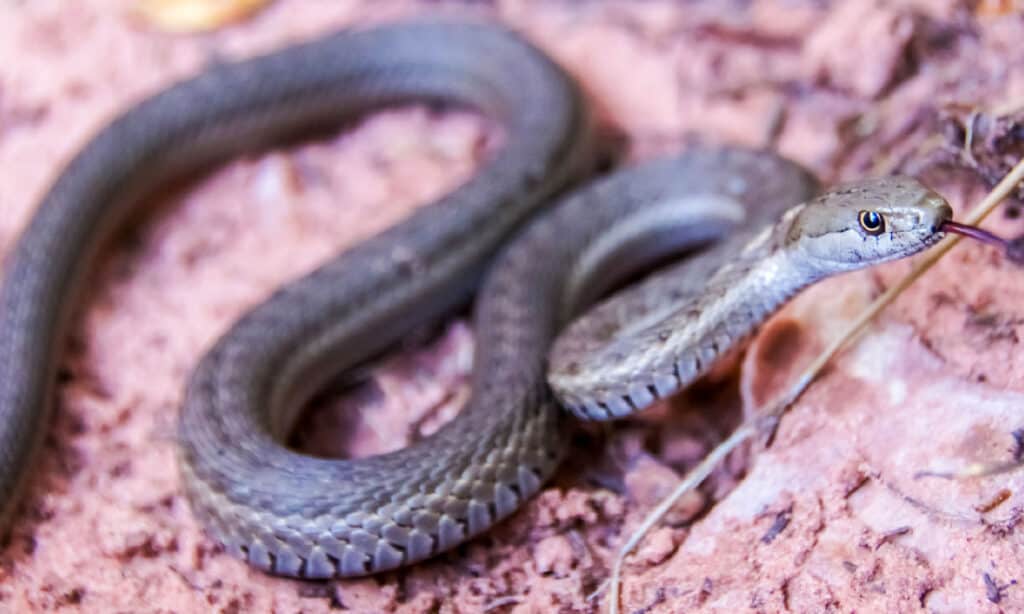Although South Dakota is best know for being part of the Great Plains region it also has numerous lakes and rivers in it. The largest river in the state is the Missouri River and this forms a natural boundary between the eastern and western parts of the state. All of these wetland regions are the perfect place for aquatic and semi-aquatic animals — including several water snakes. There are four water snakes in South Dakota from its 17 native species. So, let’s find out which they are, where they live, and what they look like!
1. Northern Water Snake (Nerodia sipedon)

Northern water snakes are a species of special concern in South Dakota.
©iStock.com/IcemanJ
The northern water snake is the only true water snake in the state, being a member of Nerodia. These snakes live in most permanent freshwater habitats — such as lakes, ponds, rivers, streams, and swamps. However, they are a species of special concern within South Dakota as they only occur in a small region near Springfield and in the Niobrara Delta near the Missouri River. Northern water snakes are usually active between April and November and will overwinter in crayfish burrows or in crevices on hillsides. They are ambush predators and prey on a variety of fish and amphibians.
Northern water snakes have thick, powerful bodies and can attain lengths of up to five feet long. They have dark brown bodies with a series of darker markings. Although their markings begin as crossbands in their neck region, they transition to blotches as they approach their tail. Northern water snakes have a very similar appearance to that of the cottonmouth snake, although the cottonmouth does not occur in South Dakota. Northern water snakes are not venomous but can be aggressive if they are threatened and will bite to protect themselves.
2. Plains Garter Snake (Thamnophis radix)

Plains garter snakes are usually active between April and October.
©Joe Farah/Shutterstock.com
Next, we have the plains garter snake which is a medium-sized snake which ranges between 16 and 28 inches long. Plains garter snakes have slender bodies with a dark brown to black ground color. They also have three very distinctive stripes. One stripe is located down the middle of their back and is typically either orange or yellow. They also have one stripe down each side which is located on scales three and four. Again, this is either yellow or orange, although they also have several alternating black spots which are located between the stripes.
Plains garter snakes live in a variety of habitats, although they are almost always located close to a permanent source of water. They are common throughout South Dakota and are usually active between April and October. They are typically diurnal snakes, although they tend to become nocturnal during the heat of the summer. Plains garter snakes mainly prey on fish, amphibians, and earthworms, although they may eat small birds and mammals when the opportunity arises.
3. Western Terrestrial Garter Snake (Thamnophis elegans)

Western terrestrial garter snakes are mainly located in the Black Hills in South Dakota.
©iStock.com/yhelfman
The next water snake in South Dakota is the western terrestrial garter snake. They only have a small range in South Dakota and are primarily located in the Black Hills. They typically inhabit areas close to water sources, such as streams and swamps. However, they may sometimes be observed further from water than some of the other garter snakes. Western terrestrial garter snakes are not venomous and consume their prey alive. Like the plains garter snakes, these snakes largely prey on fish, amphibians, and worms.
Western terrestrial garter snakes are approximately 20 to 30 inches long and are dark gray to olive green. They have a yellowish-colored dorsal stripe and two stripes along their sides on scale rows two and three. They also often have a black blotch on the back of their neck, black bars on their upper lips, and black blotches between their lateral stripes.
4. Common Garter Snake (Thamnophis sirtalis)

Common garter snakes are venomous to their prey but are not dangerous to humans.
©iStock.com/Wildnerdpix
The last snake is the common garter snake which inhabits areas around lakes, rivers, streams, and swamps. They are believed to occur statewide, although there are no verified records from the northern or central regions. Common garter snakes rarely stray far from water and again prey predominantly on fish, amphibians, and earthworms. However, these snakes are technically venomous to their prey as they produce a venom-like substance in the Durvenoy’s gland. However, this isn’t true venom and they only chew it into their prey rather than injecting it with fangs. They are also completely harmless to people, and bites from them rarely cause more than minor swelling or itching in the affected area.
Common garter snakes are 18 to 30 inches long with slender bodies. Although their appearance can vary quite a lot, in South Dakota they are usually gray or dark brown with three yellowish-coloured stripes. Like the western terrestrial garter snake, the stripes on their sides are located on scale rows two and three. They also have dark heads and vertical black bars on their upper lips.
The photo featured at the top of this post is © Alyssa Metro/Shutterstock.com
Discover the "Monster" Snake 5X Bigger than an Anaconda
Every day A-Z Animals sends out some of the most incredible facts in the world from our free newsletter. Want to discover the 10 most beautiful snakes in the world, a "snake island" where you're never more than 3 feet from danger, or a "monster" snake 5X larger than an anaconda? Then sign up right now and you'll start receiving our daily newsletter absolutely free.
Thank you for reading! Have some feedback for us? Contact the AZ Animals editorial team.






